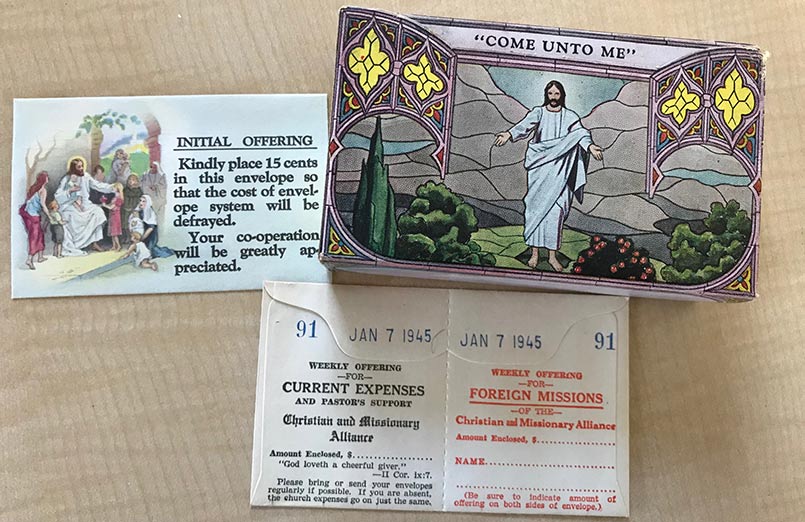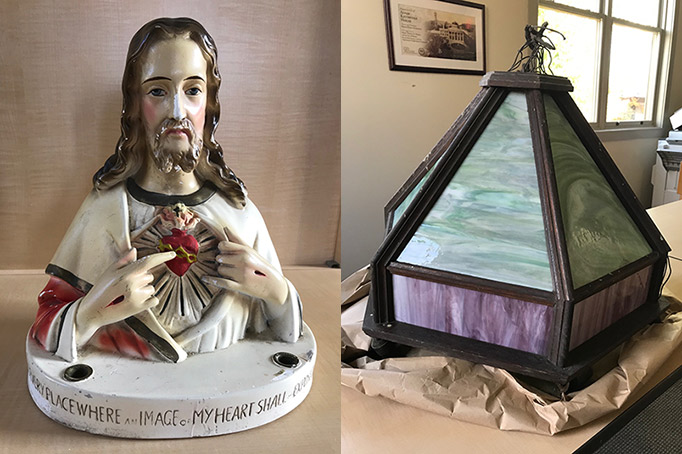
30 Oct Treasures Uncovered at 50 Cedar Shed Light on Church History
With the start of each HBI project, we are careful to collect objects left behind that help tell the history of the property. So far we have found no pots of gold, but we have discovered papers and items that enhance our understanding of the two churches that worshiped from this building.
When we acquired the St James African Orthodox Church, the space was full of stuff that previous occupants had left behind. To make certain we didn’t inadvertently throw out something historically significant, we invited Northeastern University archivist Giordana Mecagni to walk through with us and look for items of importance. While she identified a few items to remove and add to Northeastern’s permanent archives, other three-dimensional items of interest have been brought back to HBI’s offices for storage and display. Here are a few items we found interesting:

Original light fixtures – Several stained glass light fixtures were found in one of two loft areas in the sanctuary. Architect and neighbor Curtis Perrin conducted extensive research on the church’s history that was used to petition the City of Boston for landmark designation. His research revealed that the wood and stained glass chandeliers were handmade for the church by the original Norwegian congregation members. However, historic photos show that these lights where not in place for long; they appear to have been replaced fairly early on with art deco fixtures that are still in place. Perhaps the stained glass fixtures did not sufficiently light the sanctuary.
Chalkware Christ statue – Also left behind was a bust of Jesus made by Penna Statuary Co, Inc., manufactured for Langan and Bro. Inc. of Boston. Chalkware figures were made of molded plaster of Paris or sculpted gypsum, and then painted; the medium was eventually replaced by ceramic and plastic. Research suggests this statue dates to somewhere between 1930–1950, most likely belonged to the Norwegian church, based on its manufactured date. Penna created at least two variations of this bust. One was used to deliver last rites, which contained a compartment in the back that held a last rites kit (cloth and candles), as well as candle holders in the front with a slot for a crucifix. The one we found looks almost identical to this, but does not have the last rites compartment or crucifix slot, though does include candle holders. It’s unclear if this version had a specific use. Both versions of the statue are engraved “I will bless every place where an image of my heart shall be exposed and venerated.”

Offering envelopes – Perhaps the most fun item we’ve found is a box of offering envelopes from 1945 when the Norwegian Church still occupied the building. The box was intended for each church member to take home through a very organized and well-planned program of weekly giving. There is a date-stamped envelope for each week of the year, and each is split into two sections. One side of the envelope is for “Current Expenses and Pastor’s Support” and the other side is for “Foreign Missions.” There’s a place to indicate amount enclosed (perhaps to discourage against someone pilfering from the offering tray?) The envelope also provides a Bible quote to inspire generosity: “God loveth a cheerful giver –II Cor. Ix:7” If that approach didn’t work, perhaps a little guilt would help to nudge open your wallet: “Please bring or send your envelopes regularly if possible. If you are absent, the church expenses go on just the same.” Finally, church members are asked for a 15 cent initial offering to help cover the cost of the envelopes. All bases were covered.
It’s entirely possible that more items of interest will surface as our rehabilitation work continues. If so, we will happily share our findings.



